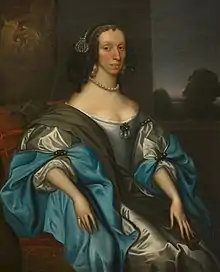Hamilton Palace
Hamilton Palace was a large country house in Hamilton, South Lanarkshire, Scotland.[1] The former seat of the Dukes of Hamilton, it dated from the 14th century and was subsequently much enlarged in the 17th and 19th centuries. Widely acknowledged as having been one of the grandest houses in the British Isles, the palace was situated at the centre of the extensive Low Parks (now Strathclyde Country Park) in the valley of the River Clyde, with the Great Avenue, a north–south tree-lined avenue over three miles (4.8 km) in length, as its axis. The Low Parks also contained the Hamilton Mausoleum designed by David Hamilton and the 11th-century Netherton Cross, while the High Parks (now Chatelherault Country Park) contained a hunting lodge designed by William Adam, which commands a broad vista northwards. Hamilton Palace was demolished in 1921, owing to the prohibitive cost of upkeep and the subsidence caused by the nearby coalmine at Bothwellhaugh.
| Hamilton Palace | |
|---|---|
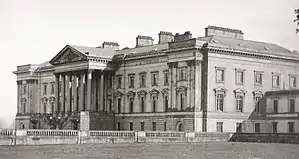 Hamilton Palace in 1916. | |
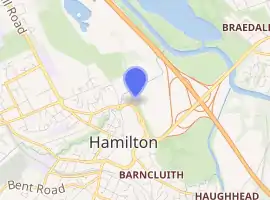
| |
| General information | |
| Status | Demolished |
| Architectural style | Palladian, Neoclassical |
| Town or city | Hamilton, South Lanarkshire |
| Country | Scotland |
| Construction started | 14th century |
| Completed | 1701, with additions 1822-1828 |
| Demolished | 1921 |
| Design and construction | |
| Architect | James Smith David Hamilton |
History
13th-16th centuries
The building at the core of Hamilton Palace was a 13th-century tower house known variously as 'The Orchard' or the 'Castle of Hamilton', which was the seat of the Hamilton family. When the palace was demolished in the 1920s, the remains of walls up to 2.7 m (8 ft 10 in) thick (compared to 0.9 m (2 ft 11 in) elsewhere in the building), were discovered in the north-west quarter, clearly indicating the defensive nature of the medieval core of the palace. 'The Orchard' was the object of much destructive attention on the part of royal armies in the period between 1565 and 1579, suffering damage in a siege of 1570 during the Marian civil war due to James Hamilton, Duke of Châtellerault's support for Mary, Queen of Scots. The castle was damaged again in 1579 on the occasion when Cadzow Castle was destroyed and left abandoned. 'The Orchard' was rebuilt and enlarged in substantial style and on a quadrangular plan during the late 16th century and is known to have accommodated King James VI himself on a hunting trip in 1589.
17th-18th centuries
Anne, 3rd Duchess of Hamilton and her husband, William, Duke of Hamilton commissioned a major rebuilding programme at Hamilton Palace from 1684 to 1701. Dubbed by the Hamilton family as 'The Great Design', these works led to the creation of a U-plan country house, with an open south-facing courtyard which followed the outline of the existing late 16th-century enclosed quadrangle. Under the direction of the architect James Smith, the south quarter of Hamilton Palace was removed entirely, the east and west quarters were rebuilt as courtyard wings, while the north wing was left much as it had been before, although it was refaced and remodelled internally. The south front was rebuilt between 1693 and 1701 in the Palladian style, the principal feature of this new formal ceremonial entrance being the frontispiece with its huge Corinthian portico. Behind the facade of the remodelled north front, the first floor was fully taken up by the Long Gallery, while the first floor of the west wing contained the main suite of ducal apartments.

A new north front had been planned by James, 5th Duke of Hamilton in the 1730s, and extensive plans were prepared by William Adam. The duke's early death and the significant costs involved prevented the external plans from being executed, but Adam did redesign several important staterooms, with stucco work by Clayton.[2] Modifications and additions continued during the next century, including the purchase or exchange of land surrounding the palace, enabling extensive landscaping to take place.[3]
19th century
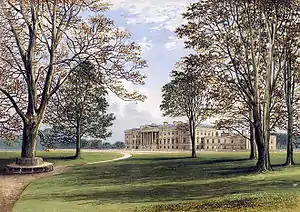
Upon his succession to the ducal title and estates in 1819, Alexander, 10th Duke of Hamilton began to enhance and enlarge the north front of Hamilton Palace, using the vast wealth that the family derived from their ownership of the Lanarkshire coalfields. The duke wanted to erect a grand residence which not only reflected the increasing wealth and national standing of the family but also provided an appropriately grand setting for the considerable art collections which he continued to gather, including the art collection and library that his wife Susan had inherited from her father William Thomas Beckford. This refurbishment included heraldic carvings in the main pediment over the entrance, carved by John Greenshields in 1822.[4] The north front itself was finally completed 1842 by architect David Hamilton using Adam's original plans as a structure. The 15-bayed, three storey north front was 265 ft (81 m) long and 60 ft (18 m) high, adorned with a Corinthian portico of monolithic columns 25 ft (7.6 m) high. New state rooms such as the Entrance Hall, the Egyptian Hall, and the Beckford Library were built. These held much fine furniture and by the mid-19th century housed one of the best private collections of paintings in Scotland, including works by Peter Paul Rubens (see below), Titian, Anthony van Dyck, and other masters. A sumptuous chimneypiece by William Morgan adorned the Dining Room's fireplace.
The new palace provided an appropriate setting for a number of magnificent social events: in 1843, a grand reception was held here following the marriage of the future 11th duke to Princess Marie Amelie of Baden, while in 1860, a great crowd gathered in the park to catch a glimpse of the visiting French empress Eugénie. The visit of Edward, Prince of Wales in 1878 concluded with a grand ball, and in 1914 a visit by King George V and Queen Mary was marked by a reception of imperial grandeur.
Decline and demolition

The demise of Hamilton Palace was the result of various factors beginning in the 19th century. After his marriage to Princess Marie Amelie of Baden in 1843, William, 11th Duke of Hamilton lived chiefly in France and Germany, took little interest in his Scottish or English affairs and never attended the House of Lords. His son, William, 12th Duke of Hamilton, took great interest in horse racing, gambling and sailing and resided at Easton Park in Suffolk, which was closer to the major race courses and also meant that he could base his steam yacht Thistle at Ipswich, from where he could sail to Brodick Castle, Cowes and racecourse venues on the continent.
By the later 19th century, the enlarged Hamilton Palace was proving expensive to maintain, and was used only as an occasional residence by the Hamilton family. The programmes of rebuilding and art collecting on the part of the 10th Duke and his successors had left a heavy burden of debt on the estate, and the Hamilton estates were no longer as profitable as they once were. The 12th Duke of Hamilton spent a fortune on horses, increasing the Hamiltons’ debts to around £1.5 million (equivalent to approximately £3.4 billion today). The 12th duke was only saved from financial ruin when his race horse Cortolvin won the Grand National Steeplechase at Aintree, with the substantial prize money and the £16,000 from the bookmakers restoring his fortune substantially. However, in order to fund his continued extravagancies, in 1882 the 12th duke was forced to sell the art cllection and Beckford Library housed in Hamilton Palace. The Hamilton Palace Sale at Christie's in London took place from 17 June to 20 July 1882 and involved the sale of some 2,213 articles from Hamilton Palace. The sale included paintings by Dürer, Rembrandt, Rubens, Velázquez and van Dyck; Chinese, Japanese, Meissen, Sèvres and English porcelain; bronzes, furniture, tapestries, chandeliers, busts, and vases. The sale raised almost £397,562 (£40 million today).
The 12th duke died aboard his yacht Thistle at Algiers in 1895. He owned 157,000 acres in Scotland and England (worth an estimated annual income of £147,000), but still had debts of £1 million. The duke's trust disposition and settlement conveyed his estate to trustees and left detailed instructions for the administration of his estate, which comprised the Hamilton Estates (in Lanarkshire, including Hamilton Palace); the Arran Estate (Brodick Castle and the greater part of the Isle of Arran); the Kinneil Estates (in Stirlingshire, including Kinneil House) and the Easton Estate and the Great Glemham Estate in Suffolk. The duke's only child was his ten-year-old daughter, Lady Mary Louise Hamilton, so the title of 13th Duke of Hamilton passed to his fourth cousin, Alfred Douglas-Hamilton, a poor Royal Navy lieutenant. The 12th duke's trustees were given power to sell the Glemham Estate and apply the proceeds, and that of some moveable property (including the duke's yacht), towards paying off the debts on the Easton Estate. The Arran and Easton Estates passed to Lady Mary and her descendants, while the Hamilton and Kinneil Estates passed to the 13th duke. The trust disposition and settlement of the 12th duke also gave the trustees power, in their sole discretion, "to entirely displenish and dismantle Hamilton Palace and take down and remove the building or allow the same to fall into disuse". The 13th duke therefore took on over £1 million in debts, which took him until July 1908 to pay off.
By the 20th century large and ostentatious houses had fallen from fashion, the cost of their upkeep was prohibitive, and the nearby coal mines resulted in dangerous subsidence in the Low Parks as the coal beneath was removed. After the thirteenth Duke lent his home for use as a naval hospital during the First World War, the state of the palace was one of severe neglect necessitating vast sums for restoration.
It was returned from hospital use in 1919, but by this time the Duke preferred the smaller and more homely Dungavel. At this time, the magazine Country Life featured a number of articles on the palace and a quantity of photographs were taken to accompany the series. As such they represent an invaluable record of the house before the massive sale of contents and fittings, and its demolition in 1921.[5]
The site today
The site of Hamilton Palace is now occupied by the Hamilton Palace Sports Grounds. Most of the palace grounds were incorporated into Strathclyde Country Park. When the park was being constructed in 1974, vaulted cellars were discovered which may have belonged to the palace. However, these were not excavated but instead infilled with rubble. Hamilton Mausoleum still stands in the park and tours can be booked at the nearby Hamilton Low Parks Museum. Several metres of wrought iron railing from the palace grounds can be seen outside Hamilton College. The dining room from Hamilton Palace is on view at the Museum of Fine Arts, Boston, in the European period rooms, where it remains the only extant, assembled room from the Palace.
The remains of the tree-lined Great Avenue that linked Hamilton Palace to Chatelherault hunting lodge can still be seen. These give the visitor a good indication, particularly from Chatelherault Country Park, of where the palace stood.
Gallery
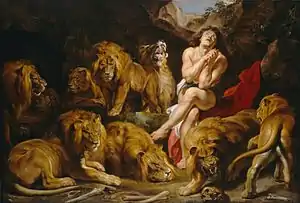 Daniel in the Lions' Den by Peter Paul Rubens which hung in the Long Gallery until it was sold in 1919
Daniel in the Lions' Den by Peter Paul Rubens which hung in the Long Gallery until it was sold in 1919 Philip IV in Brown and Silver by Diego Velázquez sold to the National Gallery in 1882
Philip IV in Brown and Silver by Diego Velázquez sold to the National Gallery in 1882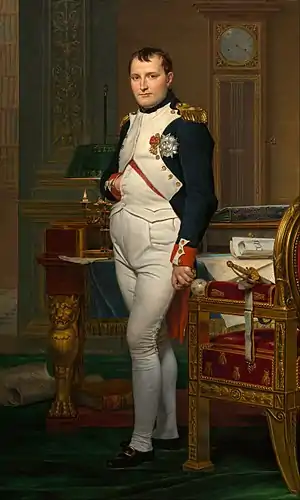 The Emperor Napoleon in His Study at the Tuileries by Jacques-Louis David which hung in the Billiard Room and later the Dining Room from 1812 until it was sold in 1882
The Emperor Napoleon in His Study at the Tuileries by Jacques-Louis David which hung in the Billiard Room and later the Dining Room from 1812 until it was sold in 1882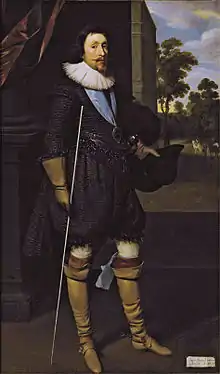 Portrait of James Hamilton, 2nd Marquess of Hamilton by Daniël Mijtens which hung in the Long Gallery
Portrait of James Hamilton, 2nd Marquess of Hamilton by Daniël Mijtens which hung in the Long Gallery Portrait of James Hamilton, 6th Duke of Hamilton by Gavin Hamilton which hung in the Long Gallery
Portrait of James Hamilton, 6th Duke of Hamilton by Gavin Hamilton which hung in the Long Gallery Assumption of the Virgin by Francesco Botticini sold to the National Gallery in 1882
Assumption of the Virgin by Francesco Botticini sold to the National Gallery in 1882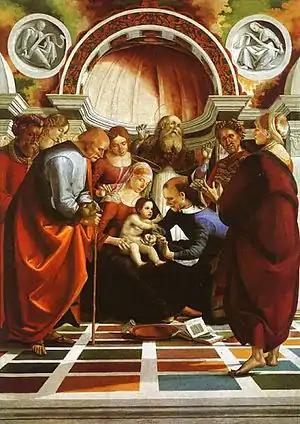 The Circumcision by Luca Signorelli sold to the National Gallery in 1882
The Circumcision by Luca Signorelli sold to the National Gallery in 1882.jpg.webp)
See also
- Strathclyde Country Park
- Chatelherault Country Park
- Ashton Hall - Lancashire seat of the Dukes of Hamilton (1698-1853)
- Brodick Castle - Isle of Arran seat of the Duke of Hamilton (1510-1895)
- Cadzow Castle - original seat of the Hamilton family
- Dungavel House - seat of the Dukes of Hamilton (1919-1947)
- Ferne House - Wiltshire seat of the Dukes of Hamilton (1914-1951)
- Kinneil House - Stirlingshire seat of the Hamilton family
- Lennoxlove House - seat of the Duke of Hamilton
References
- Hamilton's royal past, South Lanarkshire Council
- Gow, Ian (2006). Scotland's Lost Houses. Aurum Press. ISBN 1845130510.
- Walker, Gavin (1977). Hamilton Palace: A photographic record. Hamilton District Libraries. ISBN 0950198323.
- http://www.glasgowsculpture.com/pg_biography.php?sub=greenshields_j
- Avray Tipping, H. (1919) "Hamilton Palace", Country Life
External links
- Hamilton Palace: A Virtual Reconstruction - a website developed by the Virtual Hamilton Palace Trust, with maps, photographs, and virtual reconstructions of the palace.
- Hamilton Palace entry from The DiCamillo Database of British & Irish Country Houses (archive of previous version from The DiCamillo Companion)
- Hamilton Palace at Gazetteer for Scotland
- The Rise and Fall of Hamilton Palace at National Museums Scotland
